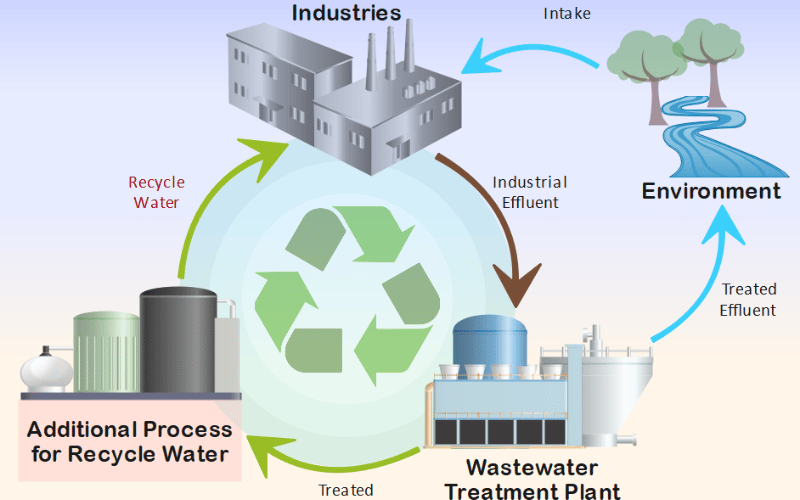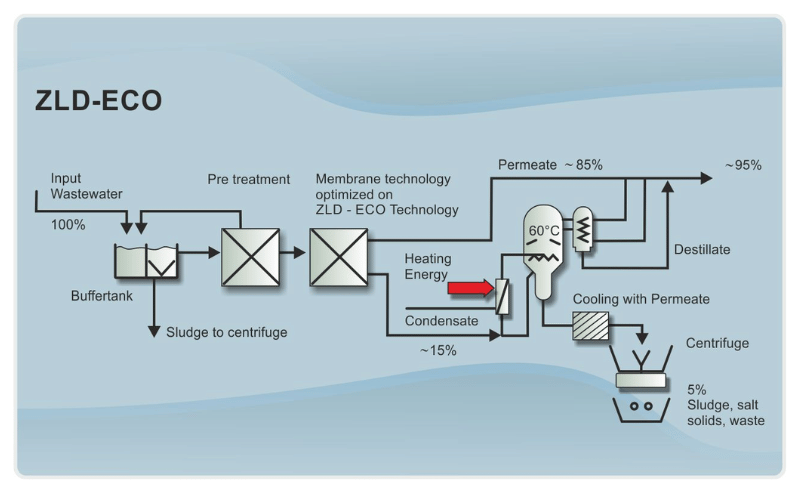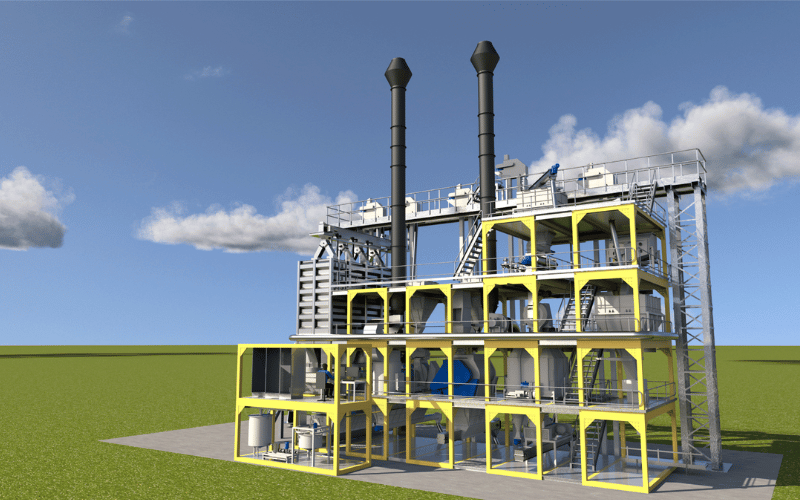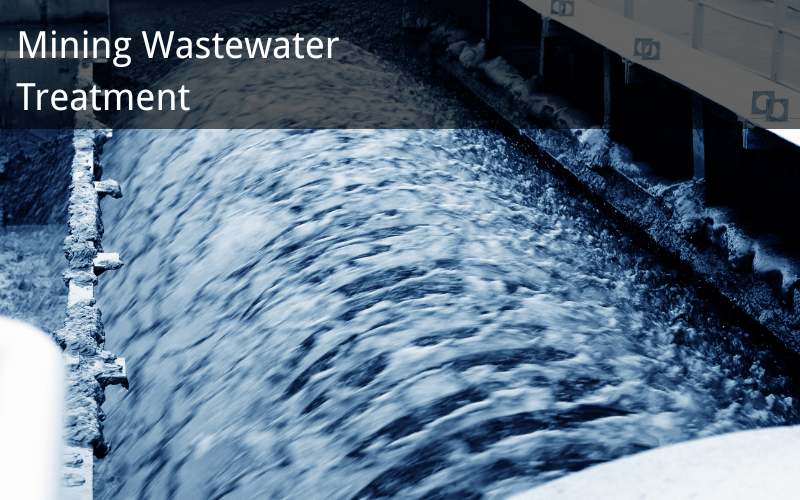Wastewater treatment in mining plays a crucial role in protecting surrounding ecosystems and ensuring sustainable resource extraction. By effectively managing and treating wastewater, mining operations can minimize environmental contamination, comply with regulations, and reduce their ecological footprint. Additionally, proper treatment enhances operational efficiency by recycling water for reuse, lowering costs, and supporting long-term resource management.
Table of Contents
ToggleWhat is Mining Wastewater Treatment?
Understanding Mining Wastewater Treatment
Mining wastewater treatment refers to the process of managing and purifying water that has been contaminated during mining operations. This water, often referred to as mine water or effluent, can contain a variety of pollutants, including heavy metals, suspended solids, chemicals, and acidic compounds. These contaminants result from activities such as ore extraction, mineral processing, and equipment washing, making the water unsuitable for direct discharge into the environment or reuse without proper treatment.
The treatment process involves a combination of physical, chemical, and biological methods to remove harmful substances and restore water quality. For example, sedimentation tanks can separate solids, chemical treatments can neutralize acidity, and advanced filtration systems can remove dissolved metals. By addressing these pollutants, mining wastewater treatment ensures that water leaving the site meets environmental standards and poses no threat to ecosystems or human health.

Why Mining Wastewater Treatment is Essential
Adequate wastewater treatment in the mining industry is crucial for both environmental compliance and sustainable operations. Mining activities often generate large volumes of wastewater, which, if left untreated, can lead to severe ecological damage. Contaminants like heavy metals and acidic water can leach into nearby rivers, lakes, and groundwater, harming aquatic life and disrupting ecosystems. Additionally, untreated wastewater can pose risks to local communities by contaminating drinking water sources and agricultural lands.
Beyond environmental protection, proper wastewater management supports operational sustainability. Treating and recycling water reduces the demand for freshwater, which is especially important in arid regions where water scarcity is a significant concern. Reusing treated water for processes such as dust suppression or equipment cooling not only conserves resources but also reduces operational costs. Moreover, adhering to strict environmental regulations helps mining companies avoid fines, legal disputes, and reputational damage, ensuring long-term viability.
In summary, mining wastewater treatment is a vital process that safeguards the environment, supports sustainable resource use, and ensures compliance with regulatory standards. By investing in effective treatment solutions, mining operations can minimize their ecological impact while maintaining efficient and responsible practices.
Key Challenges in Mining Wastewater
Common Contaminants Found in Mining Wastewater
Mining wastewater often contains a complex mix of contaminants that pose significant challenges to effective treatment. These pollutants originate from various mining activities, including ore extraction, mineral processing, and equipment cleaning. Some of the most common contaminants include:
- Heavy Metals: Metals such as lead, mercury, arsenic, and cadmium are frequently found in mining wastewater. These toxic substances can leach from ores and tailings, posing serious risks to both human health and aquatic ecosystems.
- Suspended Solids: Particles like soil, rock fragments, and mineral residues often accumulate in wastewater. These solids can increase turbidity, clog waterways, and disrupt aquatic habitats.
- Acidic Water: Acid mine drainage (AMD) is a major issue in mining wastewater. It occurs when sulfide minerals, exposed to air and water, produce sulfuric acid. This acidic water can dissolve heavy metals, further increasing the toxicity of the wastewater.
- Chemical Residues: Chemicals used in mineral processing, such as cyanide, ammonia, and flotation agents, often remain in the wastewater. These substances can be highly toxic and require specialized treatment to neutralize.
- Nutrients and Organic Compounds: In some cases, wastewater may also contain elevated levels of nutrients like nitrogen and phosphorus, as well as organic compounds that can deplete oxygen levels in water bodies.
Addressing these contaminants requires a combination of advanced treatment methods tailored to the specific composition of the wastewater.
Risks of Untreated Mining Wastewater
Failing to treat mining wastewater effectively can lead to severe environmental and operational consequences. The risks associated with untreated wastewater extend far beyond the immediate vicinity of mining sites, impacting ecosystems, communities, and even the long-term viability of mining operations.
- Acid Mine Drainage (AMD): One of the most significant risks is the formation of acid mine drainage. This highly acidic water can flow into nearby rivers, lakes, and groundwater, carrying dissolved heavy metals with it. AMD not only destroys aquatic habitats but also contaminates drinking water sources, making it unsafe for human consumption.
- Ecosystem Damage: Untreated wastewater can disrupt entire ecosystems. Heavy metals and toxic chemicals can accumulate in the food chain, harming fish, plants, and other wildlife. Suspended solids can smother aquatic habitats, reducing biodiversity and altering the natural balance of ecosystems.
- Soil and Groundwater Contamination: When mining wastewater infiltrates the soil, it can degrade its quality and render it unsuitable for agriculture or vegetation. Contaminants can also seep into groundwater, spreading pollution over a wide area and affecting water supplies for years to come.
- Regulatory and Financial Risks: Mining companies that fail to manage wastewater properly risk violating environmental regulations, leading to hefty fines, legal battles, and reputational damage. Additionally, the costs of remediating polluted sites can far exceed the expenses of implementing effective wastewater treatment systems.
- Community Health Hazards: Local communities often bear the brunt of untreated mining wastewater. Contaminated water sources can lead to serious health issues, including heavy metal poisoning, gastrointestinal diseases, and long-term developmental problems in children.
In summary, the challenges posed by mining wastewater are multifaceted, requiring proactive measures to mitigate risks. By addressing common contaminants and understanding the potential consequences of untreated wastewater, mining operations can prioritize sustainable practices that protect both the environment and surrounding communities.
Core Processes in Mining Wastewater Treatment
Sedimentation: Removing Suspended Solids
Sedimentation serves as one of the most fundamental steps in mining wastewater treatment, focusing on the removal of suspended solids. During this process, wastewater flows into large tanks or basins where gravity allows heavier particles, such as soil, rock fragments, and mineral residues, to settle at the bottom. These solids form a sludge layer, which can then be removed and treated separately.
This process not only reduces turbidity but also prevents clogging in downstream treatment systems. For example, sedimentation ensures that filtration units and membranes operate efficiently by minimizing the load of particulate matter. In some cases, coagulants or flocculants are added to the water to encourage smaller particles to clump together, making them easier to settle. By effectively removing suspended solids, sedimentation improves the overall quality of the treated water and prepares it for further purification stages.
Chemical Precipitation: Targeting Heavy Metals
Chemical precipitation plays a critical role in addressing the presence of heavy metals in mining wastewater. This process involves adding specific chemicals, such as lime, sodium hydroxide, or sulfides, to the water. These chemicals react with dissolved heavy metals like lead, arsenic, and cadmium, forming insoluble compounds that can be easily separated from the water.
For instance, when lime is added to acidic wastewater, it raises the pH level, causing metals to precipitate as hydroxides. These precipitates settle at the bottom of the treatment tank, where they can be collected and safely disposed of or further processed. Chemical precipitation not only reduces the toxicity of the wastewater but also ensures compliance with environmental discharge standards. Additionally, some advanced systems recover valuable metals from the precipitate, turning waste into a resource and enhancing the sustainability of mining operations.
Filtration: Achieving High-Quality Effluent
Filtration serves as a vital step in producing high-quality effluent by removing fine particles and residual contaminants that remain after sedimentation and chemical precipitation. This process involves passing the wastewater through a porous medium, such as sand, activated carbon, or specialized filter cartridges, to trap impurities.
Sand filters, for example, are effective at removing suspended solids and turbidity, while activated carbon filters excel at adsorbing organic compounds, odors, and residual chemicals. In mining wastewater treatment, multi-stage filtration systems are often used to address a wide range of contaminants. These systems combine different filter types to ensure comprehensive purification.
Filtration not only enhances the clarity and quality of the treated water but also prepares it for advanced treatment methods like membrane technologies. By removing even the smallest particles, filtration ensures that the final effluent meets stringent environmental and industrial standards.
Membrane Technologies: Advanced Solutions for Dissolved Contaminants
Membrane technologies, including reverse osmosis (RO) and nanofiltration (NF), provide advanced solutions for removing dissolved contaminants from mining wastewater. These processes rely on semi-permeable membranes with microscopic pores that allow water molecules to pass through while blocking dissolved salts, heavy metals, and other impurities.
- Reverse Osmosis (RO): RO systems use high pressure to force water through a membrane, effectively removing up to 99% of dissolved solids, including salts, heavy metals, and certain organic compounds. This method is particularly useful for treating brackish water or acid mine drainage, where high levels of dissolved contaminants are present.
- Nanofiltration (NF): NF membranes operate at slightly lower pressures than RO and are designed to remove divalent and larger monovalent ions, such as calcium, magnesium, and sulfates. This makes NF ideal for softening water and reducing scaling potential in industrial processes.
Both technologies produce two streams: purified water and a concentrated brine containing the removed contaminants. While the purified water can be reused in mining operations or safely discharged, the brine requires further management to minimize environmental impact. Membrane technologies not only deliver exceptional water quality but also support water recycling efforts, making them a cornerstone of sustainable mining wastewater treatment.
By combining these core processes—sedimentation, chemical precipitation, filtration, and membrane technologies—mining operations can effectively treat wastewater, protect the environment, and optimize resource use. Each step plays a unique role in addressing specific contaminants, ensuring that the treated water meets both regulatory and operational requirements.
Innovative Solutions for Mining Wastewater
Water Recycling: Reusing Treated Water for Mining Operations

Water recycling has emerged as a game-changing solution for managing wastewater in mining operations. By treating and reusing water, mining companies can significantly reduce their reliance on fresh water sources, which is especially critical in arid regions or areas facing water scarcity. Recycling treated water not only conserves natural resources but also lowers operational costs by reducing the need for continuous water procurement.
In mining, recycled water can serve multiple purposes. For instance, it can be used for dust suppression on haul roads, cooling machinery, or even in mineral processing activities. Advanced treatment technologies, such as reverse osmosis and ultrafiltration, ensure that the recycled water meets the quality standards required for these applications. Additionally, water recycling systems can be integrated into existing operations, allowing companies to create a closed-loop system that minimizes water wastage. This approach not only supports sustainable practices but also helps mining companies comply with stringent environmental regulations.
Zero Liquid Discharge (ZLD): Minimizing Environmental Impact

Zero Liquid Discharge (ZLD) represents one of the most advanced and environmentally friendly approaches to mining wastewater management. ZLD systems aim to eliminate liquid waste by recovering and reusing nearly all the water from wastewater streams, leaving behind only solid residues. This innovative solution ensures that no untreated water is discharged into the environment, thereby preventing contamination of nearby ecosystems and water bodies.
The ZLD process typically involves multiple stages, including evaporation, crystallization, and advanced filtration. Initially, wastewater undergoes pre-treatment to remove suspended solids and heavy metals. Next, evaporators concentrate the remaining water, separating it from dissolved salts and other impurities. Finally, crystallizers convert the concentrated brine into solid waste, which can be safely disposed of or repurposed, depending on its composition.
While ZLD systems require a higher initial investment compared to traditional treatment methods, their long-term benefits outweigh the costs. By achieving near-complete water recovery, ZLD not only reduces environmental risks but also enhances water reuse capabilities, making it an ideal solution for mining operations committed to sustainability.
Modular Treatment Systems: Simplifying Installation and Reducing Costs

Modular treatment systems offer a flexible and cost-effective solution for managing mining wastewater. Unlike traditional treatment plants, which require extensive construction and infrastructure, modular systems are pre-engineered units that can be quickly installed and scaled to meet the specific needs of a mining site. This plug-and-play approach simplifies the implementation process, allowing companies to deploy treatment solutions with minimal disruption to their operations.
One of the key advantages of modular systems is their adaptability. These units can be customized to address a wide range of contaminants, from heavy metals and suspended solids to chemical residues and dissolved salts. Additionally, modular systems are highly portable, making them ideal for remote or temporary mining sites where building permanent infrastructure may not be feasible.
By reducing installation time and costs, modular treatment systems enable mining companies to adopt advanced wastewater management practices without overextending their budgets. Furthermore, their compact design and energy-efficient operation make them a sustainable choice for modern mining operations. As the demand for efficient and eco-friendly solutions grows, modular systems continue to play a pivotal role in transforming wastewater treatment in the mining industry.
Benefits of Treating Mining Wastewater
Safeguarding Local Water Sources and Ecosystems
Treating mining wastewater is vital for protecting nearby water bodies and preserving ecosystems. Mining activities often release wastewater containing harmful substances like heavy metals, acidic compounds, and chemical residues. If untreated, these pollutants can infiltrate rivers, lakes, and groundwater, causing long-term damage to aquatic habitats and biodiversity. Acid mine drainage, for example, can drastically lower the pH of water, making it uninhabitable for fish, plants, and other organisms.
By using effective treatment systems, mining operations can prevent these contaminants from entering the environment. Processes like sedimentation and chemical precipitation remove harmful substances, ensuring discharged water meets safety standards. This not only protects aquatic ecosystems but also safeguards water quality for nearby communities that depend on these resources for drinking and agriculture.
Lowering Operational Costs Through Water Reuse
Recycling treated wastewater significantly reduces operational costs for mining companies. Water is essential in mining for activities like mineral processing and dust suppression, but sourcing fresh water can be expensive, especially in water-scarce regions. Treating and reusing wastewater minimizes reliance on external water supplies, leading to substantial savings.
Recycled water can be repurposed for on-site applications, such as equipment washing or cooling systems. Advanced technologies like reverse osmosis ensure the water meets quality standards for reuse. Over time, this approach not only lowers costs but also reduces the risk of water shortages disrupting operations.
Meeting Environmental Regulations and Avoiding Penalties
Adhering to environmental regulations is a critical aspect of mining operations, and wastewater treatment ensures compliance. Governments enforce strict standards on water discharge to prevent environmental harm. Non-compliance can result in fines, legal disputes, or even operational shutdowns, which can harm a company’s reputation and finances.
Effective treatment systems help mining companies meet these standards by removing contaminants and ensuring water safety. By investing in robust solutions, companies avoid penalties and maintain their licenses to operate. Compliance also demonstrates a commitment to sustainability, building trust with communities and attracting investors.
Practical Tips for Effective Wastewater Management
Develop a Water Management Plan Tailored to Site Conditions
Creating a comprehensive water management plan is the foundation of effective wastewater treatment in mining operations. Each mining site has unique characteristics, such as the type of ore being extracted, local climate conditions, and the availability of water resources. A tailored plan considers these factors to optimize water use and treatment processes. For example, in arid regions, the plan might prioritize water recycling and storage to address scarcity, while in areas with high rainfall, it could focus on managing runoff and preventing contamination.
A well-designed plan outlines the entire water lifecycle, from sourcing and usage to treatment and discharge. It identifies potential risks, such as acid mine drainage or heavy metal contamination, and incorporates strategies to mitigate them. Additionally, the plan should include contingency measures for emergencies, such as equipment failures or extreme weather events. By aligning the water management strategy with site-specific needs, mining companies can enhance efficiency, reduce costs, and minimize environmental impact.
Use Pre-Treatment to Protect Advanced Filtration Systems
Pre-treatment is a critical step in wastewater management that ensures the efficiency and longevity of advanced filtration systems. Mining wastewater often contains suspended solids, oils, and other large particles that can clog or damage filtration membranes if not removed beforehand. Pre-treatment processes, such as sedimentation, coagulation, and screening, address these issues by removing larger contaminants before the water reaches more sensitive treatment stages.
For instance, sedimentation tanks allow heavy particles to settle, while coagulation chemicals help smaller particles clump together for easier removal. These steps not only protect filtration systems but also improve their performance by reducing the load of contaminants. Advanced systems like reverse osmosis or nanofiltration operate more effectively when pre-treatment minimizes fouling and scaling risks. Investing in robust pre-treatment processes reduces maintenance costs, extends equipment lifespan, and ensures consistent water quality.
Regularly Monitor and Maintain Treatment Equipment
Consistent monitoring and maintenance of wastewater treatment equipment are essential for ensuring optimal performance and preventing costly breakdowns. Mining operations often deal with fluctuating water quality and flow rates, which can strain treatment systems. Regular inspections help identify potential issues, such as wear and tear, leaks, or declining efficiency, before they escalate into major problems.
Monitoring systems, such as sensors and automated controls, provide real-time data on key parameters like pH levels, turbidity, and contaminant concentrations. This data allows operators to make timely adjustments and ensure the treatment process remains effective. Scheduled maintenance, including cleaning membranes, replacing filters, and calibrating equipment, further enhances system reliability.
By prioritizing monitoring and maintenance, mining companies can prevent unexpected downtime, minimize repair costs, and ensure compliance with environmental regulations. A proactive approach to equipment care not only supports efficient wastewater management but also contributes to the overall sustainability of mining operations.
Conclusion
Mining wastewater treatment remains essential for protecting ecosystems, ensuring regulatory compliance, and supporting sustainable resource management. By adopting innovative and sustainable solutions, mining operations can minimize environmental impact, enhance water reuse, and contribute to a more responsible and efficient industry.


